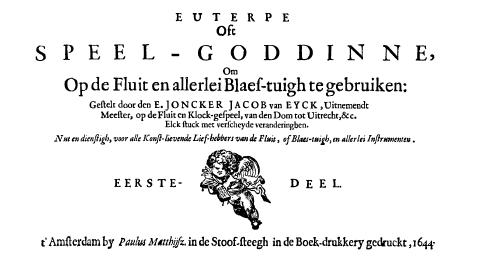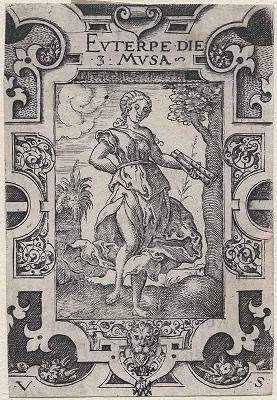|
Jacob van Eyck Quarterly |
2006, No. 4 (October) |
||
|
The titles of Jacob van Eyck's collections
In 1644 the Amsterdam publisher Paulus Matthijsz took a daring step in printing Dutch instrumental music, mainly that for the recorder. He began with the oeuvre of Jacob van Eyck, whose first volume was entitled Euterpe oft Speel-goddinne. Parallel with this edition he published Der Goden Fluit-hemel (The Gods' Flute-Heaven), an anthology of works by (for the most part) Dutch composers for one, two and three soprano recorders or other melody instruments such as the violin. These are, as far as is known, the earliest music books Matthijsz published under his own name. Later editions of work van Jacob van Eyck would continue to be accompanied by an anthology of mixed works, resulting in 'twin' editions.
Euterpe oft Speel-goddinne, second title page In 1646 Van Eyck's Euterpe I was followed by Der Fluyten Lust-hof II. There was no sequel to the Fluit-hemel; instead, Matthijsz published the first volume of 't Uitnemend Kabinet (The Excellent Cabinet), intended primarily for string instruments such as the violin and viola da gamba rather than the recorder. In 1649 Matthijsz published an expanded reprint of Van Eyck's Euterpe as Der Fluyten Lust-hof I, combining it with a new anthology, 't Uitnemend Kabinet II. In 1654 and around 1656 the editions were reprinted alternately in pairs.
Why was the second volume of Van Eyck's work (1646) not called Euterpe II but rather Der Fluyten Lust-hof II? One plausible explanation for this name change can be found in the other half of the twin editions. Matthijsz probably did not want to cause undue confusion by repeating the word 'fluyt' (flute) in parallel editions. It is strange then that in 1644 he chose to reserve 'fluyt' for the title of an anthology — Der Goden Fluit-hemel — that also contained works for violin, while its partner edition, Jacob van Eyck's Euterpe, was given a more neutral title despite being more specifically intended for the hand-flute. As said, Der Goden Fluit-hemel ('first volume') was not continued in 1646. Instead Matthijsz called his new anthology 't Uitnemend Kabinet, as it was no longer geared toward the hand-flute and therefore could hardly be called a Fluit-hemel. So the term 'fluyt', now freed up, could be applied to Van Eyck's work, and thus the name Der Fluyten Lust-hof (The Flute's Pleasure Garden) was most likely born. In choosing this pastoral-sounding title, Jacob van Eyck and Paulus Matthijsz showed themselves to be children of their time. The pleasure garden, 'planted with…', was an often-used metaphor in book titles, particularly in the case of song collections. A reader of modern Dutch might be tempted to construe 'Der Fluyten' as plural but in this case 'der fluyten' is an old genitive singular form, meaning 'of the flute'. Several decades earlier the Utrecht musician Michael Vredeman (c.1562—1629) had published a collection called Der Cyteren lusthoff, which in its French version was called Le Jardinet de Cijtere: singular. This collection could have influenced Jacob van Eyck and Paulus Matthijsz in their choice of title. Thiemo Wind
Literature: Thiemo
Wind, Jacob van Eyck en de anderen — Nederlands solorepertoire
voor blokfluit in de Gouden Eeuw (Diss. Utrecht University, 2006),
pp.103ff.
|
|||
|
No. 2007/1 will be available in January, 2007 Interested in receiving a reminder? Send an e-mail: Did you reach this page through a search engine? Click below to go to the |
|||

